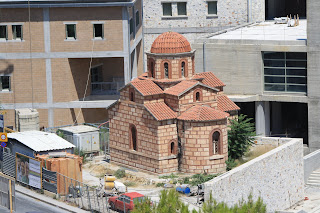The Republic of Venice was the most important trading nation in the Mediterranean region from about the 12/13th Century until finally being defeated by the Ottoman Empire in the 17th Century. Heraklion itself was beseiged by the Ottomans for 25 years before falling in 1669, with Crete being a part of the Ottoman Empire for the next 200 years.
This Venetian-built fortress, built 1523-1540, guards the port at Heraklion.
 The sea side of the fortress with the Lion of St. Mark, symbol of the Venetian republic.
The sea side of the fortress with the Lion of St. Mark, symbol of the Venetian republic.

The huge Athens-Heraklion ferry of the Minoan Lines is about the same size as the fortress; at least in height.
 From the fortress toward the city. The giant arched structure is part of the Venetian shipyard; there were 17 such structures around the harbor where ships could be drydocked for repairs, or built new.
From the fortress toward the city. The giant arched structure is part of the Venetian shipyard; there were 17 such structures around the harbor where ships could be drydocked for repairs, or built new.
 Part of the Venetian defensive wall around the city.
Part of the Venetian defensive wall around the city.
 Interior of the same drydock structure shown before.
Interior of the same drydock structure shown before.

 From the fortress toward the city. The giant arched structure is part of the Venetian shipyard; there were 17 such structures around the harbor where ships could be drydocked for repairs, or built new.
From the fortress toward the city. The giant arched structure is part of the Venetian shipyard; there were 17 such structures around the harbor where ships could be drydocked for repairs, or built new. Part of the Venetian defensive wall around the city.
Part of the Venetian defensive wall around the city. Interior of the same drydock structure shown before.
Interior of the same drydock structure shown before.
Yenicar Aga Fountain built into the city wall.
Nikos Kazantzakis is buried in this small park atop the wall. He was born in Heraklion and lived there; author of Zorba the Greek and The Last Temptation of Christ, among other works.
Makasi Stoa. This long corridor led from the inside of the city, through the inner wall to the bastion on the exterior of the wall, and enabled troops to quickly and safely travel inside the fortifications. It is now a shrine to those killed in defense of Crete during the Nazi invasion. There are photos on the walls and artifacts in cases along the walls.


St. Minas orthodox church on the right, and "little" St. Minas on the left. Little St. Minas was built in 1735. The Cathedral St. Minas was built 1862-1895.




 Morosini fountain, the terminous of an aqueduct, built in 1628.
Morosini fountain, the terminous of an aqueduct, built in 1628.
 Venetian Loggia, the building is simply called "Loggia." Restored and serves as city hall.
Venetian Loggia, the building is simply called "Loggia." Restored and serves as city hall.






 Morosini fountain, the terminous of an aqueduct, built in 1628.
Morosini fountain, the terminous of an aqueduct, built in 1628. Venetian Loggia, the building is simply called "Loggia." Restored and serves as city hall.
Venetian Loggia, the building is simply called "Loggia." Restored and serves as city hall.







No comments:
Post a Comment